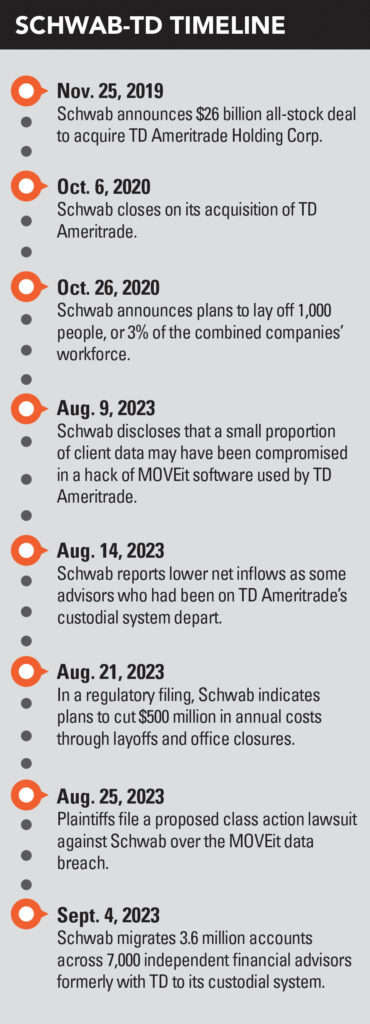

Charles Schwab’s much-anticipated transition in September for independent advisors from TD Ameritrade’s custodial system reportedly went off without a hitch — but not everyone is happy with the change.
It’s been two months since the big move to Schwab Advisor Services — involving 3.6 million accounts among about 7,000 RIAs — and while the process itself has been praised as smooth, some advisors are taking issue with the house in which they’re now living.
The list of complaints ranges from minor quirks, such as having to deal with numerous master accounts in Schwab’s system, to more serious ones, including an accusation that the firm is trying to muscle in on their relationship with clients.
That’s driven some advisors to start adding custodians, particularly for new clients, often those who are younger and more technology-fluent. But none of the advisors who spoke with InvestmentNews indicated plans to leave Schwab altogether, in part because the idea of repapering is too much to bear.
In its quarterly earnings call in mid-October, Schwab executives paraded the Labor Day weekend migration of RIA accounts, citing low attrition rates ahead of that and few customer complaints since.
“Even the most negative observers have acknowledged the skill and attention to detail that is going into our integration efforts. And clients are responding,” CEO Walt Bettinger said. “Former Ameritrade retail clients are awarding us levels of loyalty and retention that are far better than we anticipated when we announced the acquisition back in 2019. Similarly, attrition from former TD RIA custodial clients is also below our estimates.”
The firm has switched over three of the five groups it is moving from TD Ameritrade’s systems to its own, with the most recent being RIA clients. The two groups yet to be moved include some of its retail customers and active traders.
During the massive RIA move, customer service calls were answered within a minute, and complaints since the move have been low, Bettinger said.
“We are averaging 45 complaints for [every] 1 million converted accounts,” he said, comparing that with 200 complaints per million accounts during the early 2021 meme stock craze.
But, he said, “clearly there was an adjustment period for some our clients as they familiarized themselves with new processes, new websites, new mobile apps.”
Leading up to the RIA account switch, there had been an airing of grievances on Twitter, but it’s unclear how widespread the discontent with the departure from TD was.
John Biebel, chief client officer at Ridley Cove Financial Advisors, said the transition itself was smooth and that he’s grateful Schwab will retain TD’s iRebal portfolio management technology.
However, leading up to the transition, he and firm clients experienced frustration with Schwab’s communications, including complex letters for 401(k) account holders asking them for restatement — letters that he didn’t receive, he said. Many of those clients had opted for electronic communication at TD.
“I can’t even imagine how many trees were decimated for that,” Biebel said.
The 401(k) restatement letters “were so ridiculously complex that none of my clients would ever consider doing them themselves. They forwarded them to me,” he said.

Although Biebel “wanted to be a one-custodian shop,” he has started using Betterment, Equity Advisor Solutions, Altruist and Fidelity for some accounts, he said.
Much of the reason is that opening accounts is simple, particularly if clients are comfortable doing everything online, he said.
“My plan going forward is to have Schwab as my default but to continue to send certain clients to Betterment and continue to learn how to use the system, and also be very open to looking at other custodial platforms,” he said.
“Repapering is a pain,” Biebel said, but the biggest issue for him is the ease of onboarding. Currently, he contracts account openings at Schwab, as he did with TD, to a service team that helps clients with Docusign and paperwork being kicked back, which can result in long phone calls and time on hold, he noted. “Once the clients’ money hits the account, Betterment invests in my models. I don’t have to do anything. It’s done.”
Another advisor, who didn’t want to be identified because of his working relationship with Schwab, said he has moved “a sizable chunk” of accounts to Betterment for the same reason.
“Betterment has a completely streamlined account opening and transfer process,” he said. That has resulted in fewer requests being kicked back for documents not being in good order. “It’s cut down on our time to onboard clients.”
One thing that advisor’s firm is getting used to is the number of master accounts at Schwab.
“We’re a small firm and we have six master accounts,” he said. “It’s just a different way of doing things.”
Schwab’s decision not to use TD’s Veo One system was also disappointing, he said.
However, the advisor, despite being pessimistic ahead of the account migration, which he thought “was going to be a nightmare,” conceded that “it actually went pretty smoothly.”
Additionally, some clients simply like Schwab for the sake of name recognition, he said. “I think you’re going to see that more and more in the RIA space, where you have your preferred custodian for this and your preferred custodian for that.”
Another advisor who wished to remain anonymous said he was upset about Schwab’s service line for RIA clients including a message that tells people where to go to open a retail brokerage account. With TD, advisors could be involved in helping clients resolve tech issues with their accounts, but that seems to be less the case with Schwab, he said.
“Schwab is not treating advisors right, in my opinion … They feel these clients are their clients,” he said. “They’re clearly trying to undermine the relationship between clients and advisors.”
He is not planning to switch custodians yet but is interested in Altruist for the future, the advisor said.
In a statement provided by a public relations firm, Schwab stated that the TD migration has necessitated that advisors’ clients set up credentials with Schwab Alliance, and it has provided tech support to do so.
The Alliance system “is intended to reinforce the relationship between clients and their advisors, and customization includes individual firm branding” in addition to providing on-demand access to accounts, according to the statement.
“We have seen high levels of adoption of our single-workflow, multi-account, 100% digital account onboarding,” read a statement from the PR firm attributed to Jalina Kerr, managing director of strategy integration and client experience at Schwab Advisor Services. “That said, transitioning to something new is challenging and we are working through an expected period of adjustment and actively seeking advisor feedback to shape immediate priorities … Our key priority right now is to support advisors who are adjusting and to resolve any issues quickly.”
One advisor, Chuck Rosen, CEO of CPR Financial, noted that although the switch from TD to Schwab was a long process — given that the acquisition was announced in 2019 — the event itself was seamless, and that Schwab’s phone support is significantly better than was TD’s. It was also helpful that Schwab made substantial efforts to train advisors on its systems ahead of time, he said.
While a downside has been the fact that his RIA, which has 600 accounts with Schwab, has 13 different master accounts, the lack of repapering “helped Schwab make their transition very sticky for those of us who were with TD.”
Repapering “is so much paperwork,” Rosen said. “And I know because I did it once. It was horrible, and it took months to do.”

Relationships are key to our business but advisors are often slow to engage in specific activities designed to foster them.

Whichever path you go down, act now while you're still in control.

Pro-bitcoin professionals, however, say the cryptocurrency has ushered in change.

“LPL has evolved significantly over the last decade and still wants to scale up,” says one industry executive.

Survey findings from the Nationwide Retirement Institute offers pearls of planning wisdom from 60- to 65-year-olds, as well as insights into concerns.
Streamline your outreach with Aidentified's AI-driven solutions
This season’s market volatility: Positioning for rate relief, income growth and the AI rebound
